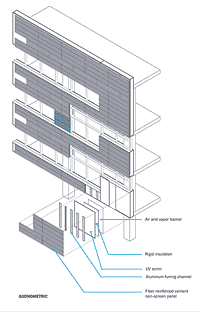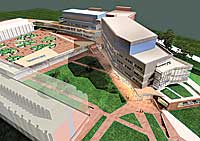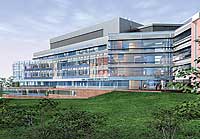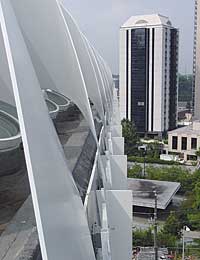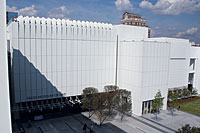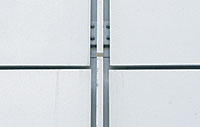Rain-Screen Facades Are More Than Skin Deep
Weight-loss strategy
Despite the promise of performance advantages, worries about water penetration are often not the determining factor in the selection of a rain screen over a more traditional cladding system. For example, when 4240 Architecture renovated a 32,000-square-foot office building in Denver's Cherry Creek neighborhood, the need for a lightweight system made a terra-cotta rain screen a good choice. Because the concrete floor slabs of the four-story building, constructed in 1963, were not up to current code, the architect was limited to systems that weighed no more than 10 pounds per square foot. Even after reinforcement of the structure at column locations with shear collars, the use of brick, the client's preferred material, was not an option. "That is what led us to terra-cotta, which has the warmth of brick," says Geoffrey Brooksher, AIA, 4240 senior associate.
During the nine-month, $4 million gut renovation project completed in spring 2006, the contractor, PCL Construction Services, reduced the building to its structural frame, removing interior partitions and finishes. It replaced the original glass curtain wall and expanded metal sunscreen facade-which had earned the building the nickname "the cheese grater"-with a wall assembly composed of standard 6-inch metal-stud framing, sheathing, a combined vapor and air barrier, rigid insulation, and the 1¼2-inch-thick terra-cotta panels hung on an aluminum angle and support rail system.
The relative position of the materials provided energy-performance benefits, according to Brooksher. Because the cladding system was lightweight, the architect was able to pull the rain screen away from the face of the slabs and provide enough space outboard of the stud wall for 3 inches of rigid insulation. The configuration eliminated thermal bridging, or loss of heat through the studs, and increased the insulation's effectiveness by about 30 percent, he says.
To prevent pressure variation across the cladding surface, and to help the cavity achieve pressure equalization, each panel is surrounded by a 3¼16-inch open joint, and the cavities within the four facades are divided into discrete compartments with aluminum closures, or delimiters, at the building's corners. The team decided not to pursue further compartmentalization because the basic wind-loading calculations required by code for any facade system, rain screen or otherwise, indicated that the building face did not have a large variation in wind pressure, according to Brooksher. However, he adds, "In larger buildings, compartmentalization is a bigger issue."
Wall components primarily intended to serve other purposes can sometimes do double duty as air-chamber delimiters. This was the approach followed by Renzo Piano, in collaboration with local architect Lord Aeck Sargent, when the two firms created a villagelike complex to expand Atlanta's High Museum. The High project, completed in late 2005, has a rain-screen system composed of 4-foot-by-12-foot aluminum panels surrounded by 3¼4-inch reveals and hung about 2 inches off the building's weatherproof stud backup wall. Steel fins run vertically between each row of panels and project beyond the edge of the facade.
Although Piano conceived the fins primarily as a device for casting shadows on the building surface, they also break up the cavity internally and slow the flow of wind gusts through it. Because of the relatively low height of the museum's complex of buildings (about 75 feet) and the protected courtyard space that their configuration creates, a separate compartmentalization strategy was not necessary, according to McClelland of Arup, the project's facade consultant. "If it were a 40-story building, we would have been more concerned," he says, echoing Brooksher's comments about 4240's Denver project.
A distinctive feature of the High's rain screen is its integration with the devices that shade the museum's signature round light scoops. The top row of aluminum panels bend above the parapet to transform into sail-like screens that prevent direct sunlight from entering the galleries below. Arup performed three-dimensional analysis and ordered a full-scale mock-up of the panel to identify any inherent weaknesses in the unusual shape.





